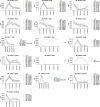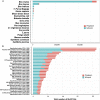Comparative Transcriptomics of the Bovine Apicomplexan Parasite Theileria parva Developmental Stages Reveals Massive Gene Expression Variation and Potential Vaccine Antigens
- PMID: 32582776
- PMCID: PMC7296165
- DOI: 10.3389/fvets.2020.00287
Comparative Transcriptomics of the Bovine Apicomplexan Parasite Theileria parva Developmental Stages Reveals Massive Gene Expression Variation and Potential Vaccine Antigens
Abstract
Theileria parva is a protozoan parasite that causes East Coast fever (ECF), an economically important disease of cattle in Africa. It is transmitted mainly by the tick Rhipicephalus appendiculatus. Research efforts to develop a subunit vaccine based on parasite neutralizing antibodies and cytotoxic T-lymphocytes have met with limited success. The molecular mechanisms underlying T. parva life cycle stages in the tick vector and bovine host are poorly understood, thus limiting progress toward an effective and efficient control of ECF. Transcriptomics has been used to identify candidate vaccine antigens or markers associated with virulence and disease pathology. Therefore, characterization of gene expression throughout the parasite's life cycle should shed light on host-pathogen interactions in ECF and identify genes underlying differences in parasite stages as well as potential, novel therapeutic targets. Recently, the first gene expression profiling of T. parva was conducted for the sporoblast, sporozoite, and schizont stages. The sporozoite is infective to cattle, whereas the schizont is the major pathogenic form of the parasite. The schizont can differentiate into piroplasm, which is infective to the tick vector. The present study was designed to extend the T. parva gene expression profiling to the piroplasm stage with reference to the schizont. Pairwise comparison revealed that 3,279 of a possible 4,084 protein coding genes were differentially expressed, with 1,623 (49%) genes upregulated and 1,656 (51%) downregulated in the piroplasm relative to the schizont. In addition, over 200 genes were stage-specific. In general, there were more molecular functions, biological processes, subcellular localizations, and pathways significantly enriched in the piroplasm than in the schizont. Using known antigens as benchmarks, we identified several new potential vaccine antigens, including TP04_0076 and TP04_0640, which were highly immunogenic in naturally T. parva-infected cattle. All the candidate vaccine antigens identified have yet to be investigated for their capacity to induce protective immune response against ECF.
Keywords: Theileria parva; piroplasm; schizont; transcriptome; vaccine antigens.
Copyright © 2020 Atchou, Ongus, Machuka, Juma, Tiambo, Djikeng, Silva and Pelle.
Figures








Similar articles
-
Transcriptomics reveal potential vaccine antigens and a drastic increase of upregulated genes during Theileria parva development from arthropod to bovine infective stages.PLoS One. 2018 Oct 10;13(10):e0204047. doi: 10.1371/journal.pone.0204047. eCollection 2018. PLoS One. 2018. PMID: 30303978 Free PMC article.
-
Immunity and vaccine development in the bovine theilerioses.Adv Parasitol. 1999;44:41-97. doi: 10.1016/s0065-308x(08)60230-4. Adv Parasitol. 1999. PMID: 10563395 Review.
-
Induction of humoral immune response to multiple recombinant Rhipicephalus appendiculatus antigens and their effect on tick feeding success and pathogen transmission.Parasit Vectors. 2016 Sep 2;9(1):484. doi: 10.1186/s13071-016-1774-0. Parasit Vectors. 2016. PMID: 27589998 Free PMC article.
-
Theileria parva candidate vaccine antigens recognized by immune bovine cytotoxic T lymphocytes.Proc Natl Acad Sci U S A. 2006 Feb 28;103(9):3286-91. doi: 10.1073/pnas.0511273103. Epub 2006 Feb 21. Proc Natl Acad Sci U S A. 2006. PMID: 16492763 Free PMC article. Clinical Trial.
-
Theileria parva: influence of vector, parasite and host relationships on the epidemiology of theileriosis in southern Africa.Parasitology. 1991 Jun;102 Pt 3:347-56. doi: 10.1017/s0031182000064295. Parasitology. 1991. PMID: 1907728 Review.
Cited by
-
Mining gene expression data for rational identification of novel drug targets and vaccine candidates against the cattle tick, Rhipicephalus microplus.Exp Appl Acarol. 2023 Oct;91(2):291-317. doi: 10.1007/s10493-023-00838-8. Epub 2023 Sep 27. Exp Appl Acarol. 2023. PMID: 37755526 Free PMC article.
-
Dual RNA-seq to catalogue host and parasite gene expression changes associated with virulence of T. annulata-transformed bovine leukocytes: towards identification of attenuation biomarkers.Sci Rep. 2023 Oct 24;13(1):18202. doi: 10.1038/s41598-023-45458-9. Sci Rep. 2023. PMID: 37875584 Free PMC article.
-
Can the Revolution in mRNA-Based Vaccine Technologies Solve the Intractable Health Issues of Current Ruminant Production Systems?Vaccines (Basel). 2024 Jan 31;12(2):152. doi: 10.3390/vaccines12020152. Vaccines (Basel). 2024. PMID: 38400135 Free PMC article. Review.
-
Design and evaluation of vaccines for the control of the etiological agent of East Coast fever.Parasit Vectors. 2024 Nov 20;17(1):479. doi: 10.1186/s13071-024-06517-w. Parasit Vectors. 2024. PMID: 39567980 Free PMC article. Review.
-
The Hypervariable Tpr Multigene Family of Theileria Parasites, Defined by a Conserved, Membrane-Associated, C-Terminal Domain, Includes Several Copies with Defined Orthology Between Species.J Mol Evol. 2023 Dec;91(6):897-911. doi: 10.1007/s00239-023-10142-z. Epub 2023 Nov 28. J Mol Evol. 2023. PMID: 38017120 Free PMC article.
References
-
- Norval RAI, Perry BD, Young AS. The Epidemiology of Theileriosis in Africa. London: Academic Press; (1992) xiii:481. - PubMed
LinkOut - more resources
Full Text Sources
Miscellaneous

